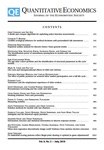
Aydogan, I., Baillon, A., Kemel, E. and Li, C. (2025). How much do we learn?: Measuring symmetric and asymmetric deviations from Bayesian updating through choices Quantitative Economics, 16(1):329--365.
-
Affiliated authorsAurélien Baillon, Chen Li
-
Publication year2025
-
JournalQuantitative Economics
Belief-updating biases hinder the correction of inaccurate beliefs and lead to suboptimal decisions. We complement Rabin and Schrag's (1999) portable extension of the Bayesian model by including conservatism in addition to confirmatory bias. Additionally, we show how to identify these two forms of biases from choices. In an experiment, we found that the subjects exhibited confirmatory bias by misreading 19% of the signals that contradicted their priors. They were also conservative and acted as if they missed 28% of the signals.